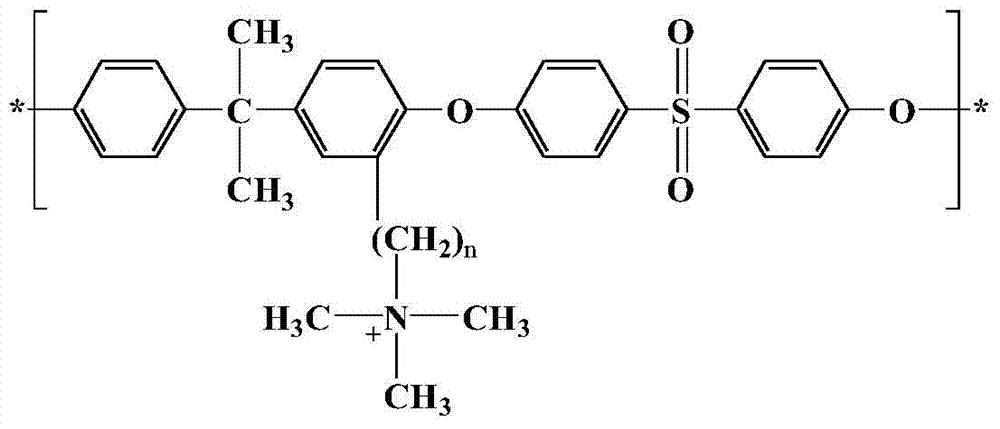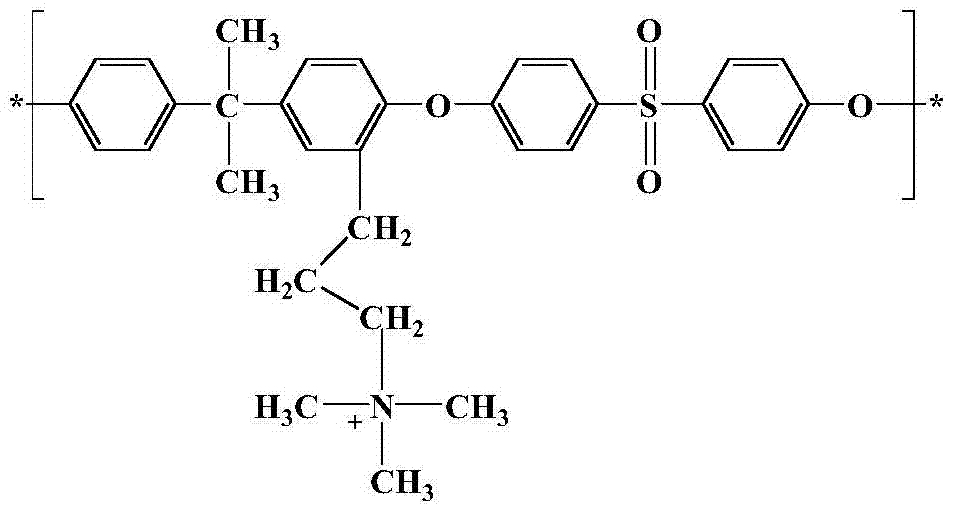A kind of long-chain branched polysulfone anion membrane and preparation method thereof
An anion exchange membrane, long-chain technology, applied in the field of long-chain branched polysulfone anion membrane and its preparation, can solve the problems of increased water absorption, decreased membrane mechanical properties, etc., to reduce swelling, improve connectivity, high ionic The effect of conductivity
- Summary
- Abstract
- Description
- Claims
- Application Information
AI Technical Summary
Problems solved by technology
Method used
Image
Examples
Embodiment 1
[0021] Because the acylation reaction requires anhydrous reaction, various flasks and other instruments need to be evacuated under double-row tubes before the experiment. When evacuating, use an alcohol lamp to burn the flask. Pour in an inert gas such as nitrogen, and then evacuate, and reciprocate 2-3 times. Then, under the protection of nitrogen, add 1g of PSF solid and 40ml of dichloromethane (put into active molecular sieve one week in advance) to dissolve at room temperature. After dissolving, add 2ml of anhydrous tin tetrachloride, and then place the reaction in an ice-water bath. After 15 minutes, when the temperature drops to 3°C, mix 1ml of the acylating reagent 3-bromopropionyl chloride with 10ml of dichloromethane in In the normal pressure dropping funnel, under the protection of nitrogen, slowly drop the reaction solution. Because the acylation reaction will release hydrogen chloride gas, a bubbler is connected to the other outlet of the flask during the dropwise ...
Embodiment 2
[0030] The flask was evacuated under a double-row tube, and then under nitrogen protection, 1 g of PSF solid and 40 ml of dichloromethane (activated molecular sieves were put in one week in advance) were added to dissolve at room temperature. After dissolving, add 2ml of anhydrous tin tetrachloride, and then place the reaction in an ice-water bath. After 15 minutes, when the temperature drops to 3°C, mix 1ml of the acylating reagent 6-bromohexanoyl chloride with 10ml of dichloromethane in In the normal pressure dropping funnel, under the protection of nitrogen, slowly drop the reaction solution. Because the acylation reaction will release hydrogen chloride gas, a bubbler is connected to the other outlet of the flask during the dropwise addition, and then a rubber tube is connected to the water to absorb the gas generated by the reaction and ensure that the pressure in the flask is moderate. The dropwise addition was completed in 20 minutes. Then the ice-water bath was removed...
Embodiment 3
[0038] The flask was evacuated under a double-row tube, and then under nitrogen protection, 0.5 g of PSF solid and 15 ml of dichloromethane (activated molecular sieves were put in one week in advance) were added to dissolve at room temperature. After dissolving, add 2ml of anhydrous tin tetrachloride, and then place the reaction in an ice-water bath. After 15 minutes, when the temperature drops to 3°C, mix 2ml of the acylating reagent 6-bromohexanoyl chloride with 10ml of dichloromethane in In the normal pressure dropping funnel, under the protection of nitrogen, slowly drop the reaction solution. Because the acylation reaction will release hydrogen chloride gas, a bubbler is connected to the other outlet of the flask during the dropwise addition, and then a rubber tube is connected to the water to absorb the gas generated by the reaction and ensure that the pressure in the flask is moderate. The dropwise addition was completed in 20 minutes. Then the ice-water bath was remov...
PUM
| Property | Measurement | Unit |
|---|---|---|
| water absorption | aaaaa | aaaaa |
| water absorption | aaaaa | aaaaa |
| water absorption | aaaaa | aaaaa |
Abstract
Description
Claims
Application Information
 Login to View More
Login to View More - R&D
- Intellectual Property
- Life Sciences
- Materials
- Tech Scout
- Unparalleled Data Quality
- Higher Quality Content
- 60% Fewer Hallucinations
Browse by: Latest US Patents, China's latest patents, Technical Efficacy Thesaurus, Application Domain, Technology Topic, Popular Technical Reports.
© 2025 PatSnap. All rights reserved.Legal|Privacy policy|Modern Slavery Act Transparency Statement|Sitemap|About US| Contact US: help@patsnap.com



